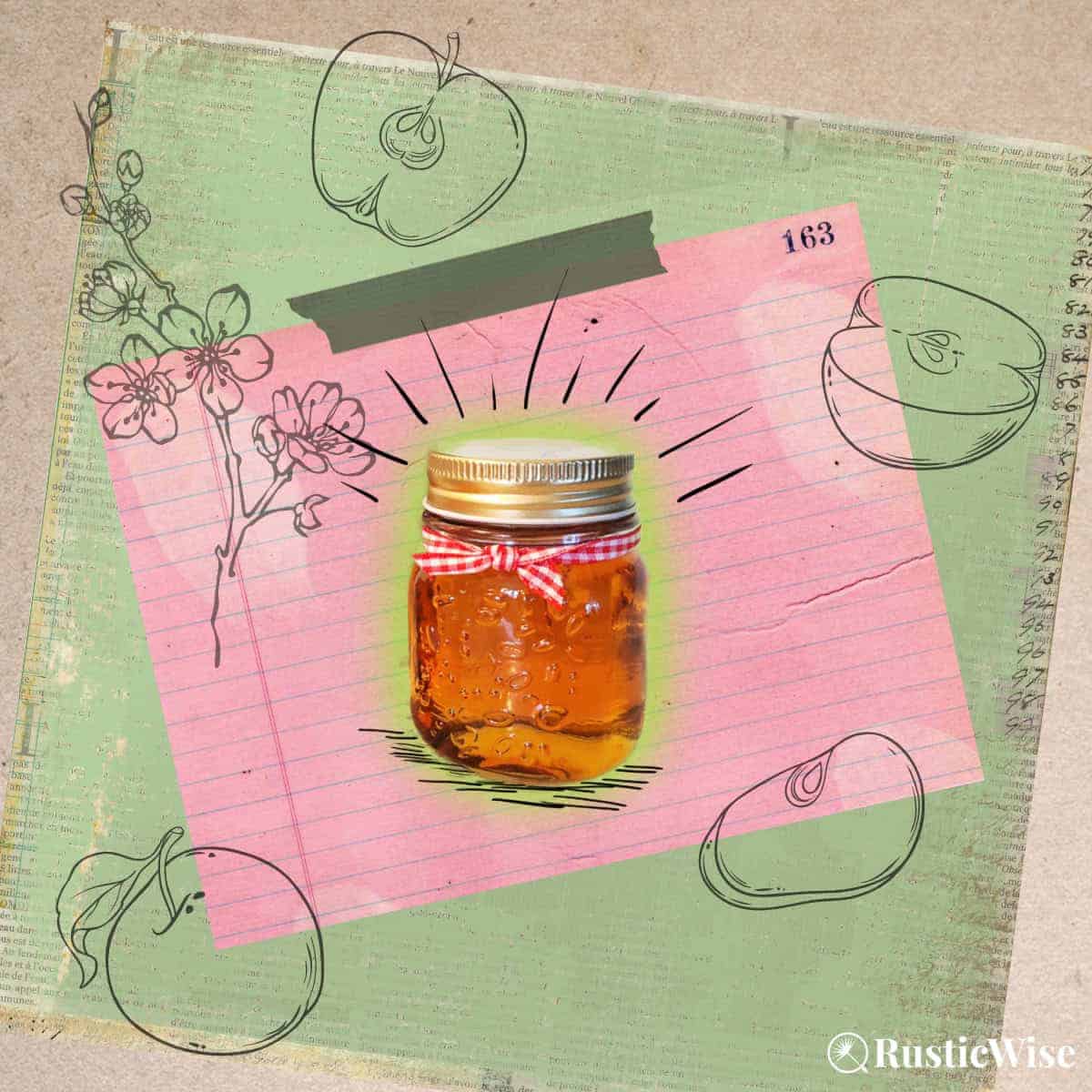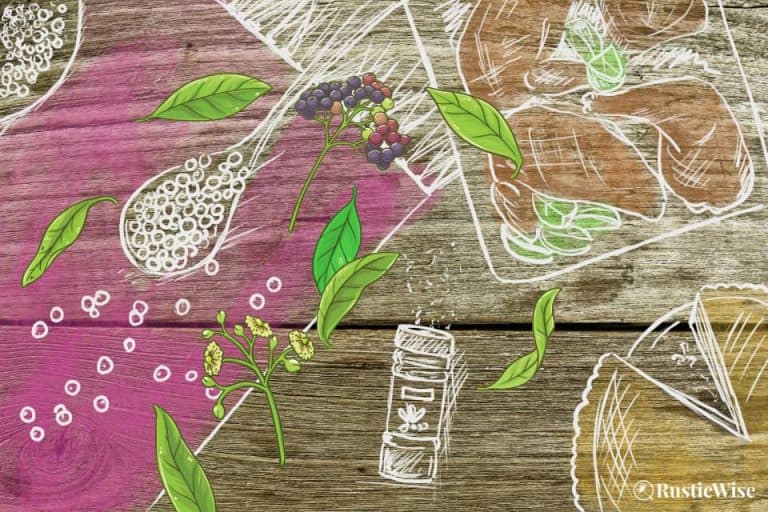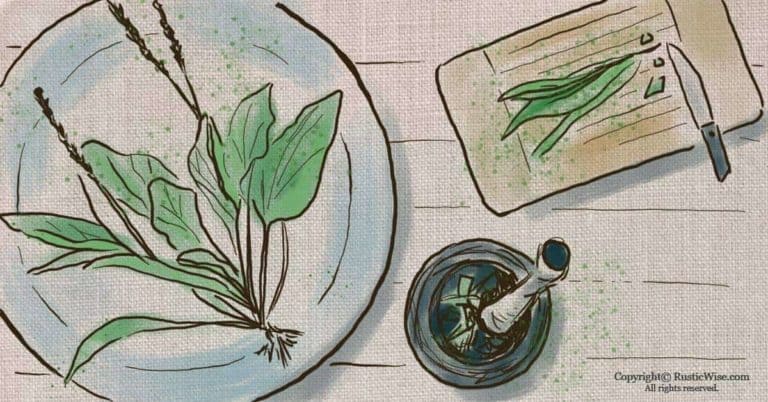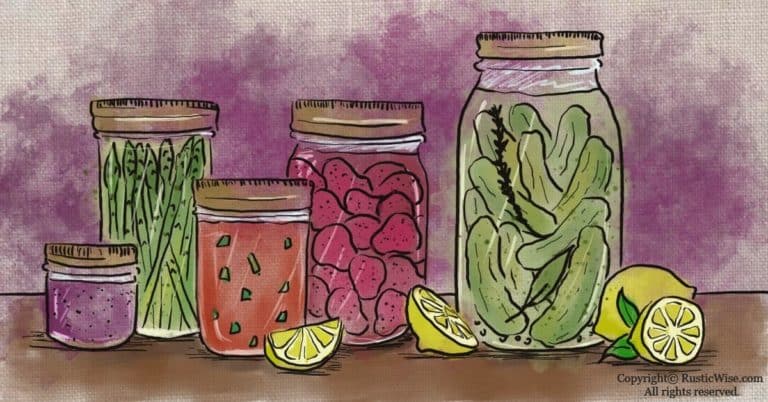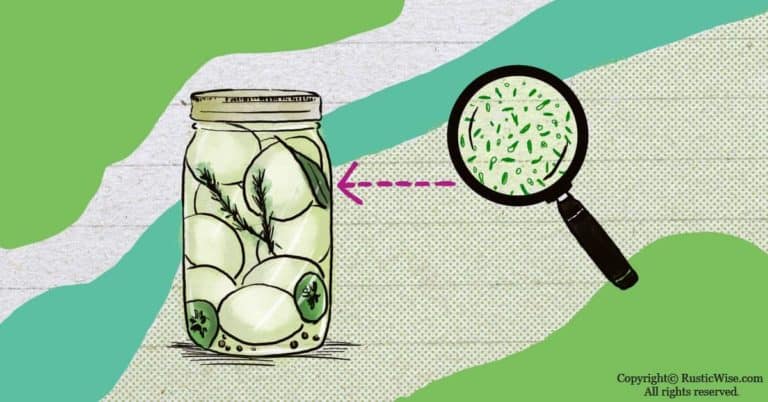Easy DIY Crab Apple Liqueur Recipe: 3 Variations
Every year, my in-laws’ sprawling crab apple tree produces more small fruits than they know what to do with. Most of it goes to waste. So, when life gives you crab apples, make homemade crab apple liqueur!
I have a super-easy DIY crab apple liqueur recipe to share with you. Actually, I have 3 variations: the basic recipe with vodka, one using whisky, and another with extra spice. Making homemade fruit liqueur is easier than it sounds and mostly hands-off: wash and cut fruit; stuff in jars along with sugar and seasonings; fill with alcohol; cover, and let it sit for weeks, while swirling occasionally.
Come Christmas time, you’ll have some to give away as gifts. (But judging by how tasty my batches have turned out, you might not want to share!)
What are crab apples?
Crab apples are a type of small, tart fruit that grows on trees belonging to the Malus genus. There are many varieties of crab apples, but they share a similar taste. You’ll find these mouth-puckering fruits in a variety of colors, including red, yellow, and green. They’re closely related to traditional apples but are typically much smaller and more sour in taste.
Unless your tastebuds favor sour, citrusy flavors, some people find eating the fruits fresh from the tree a bit much.
Besides making tasty homemade liqueur with them, you can also use them in other culinary dishes such as jams, jellies, and sauces. (Keep reading to the bottom to find out how we use leftover crab apples as a simple syrup on a cold treat!)
Where to find crab apples
If you’re lucky enough to have a crab apple tree in your backyard, then you’re golden. Otherwise, you can offer to harvest the fruits from a neighbor or friend (you’ll actually be doing them a favor, I bet!).
And if you live in a temperate region throughout the Northern hemisphere, you can sometimes find these trees growing wild. However, if you plan on foraging these fruits, please ensure you’ve identified the trees correctly first, and only harvest from trees that are free of chemicals.
Depending on your local market, you can also sometimes pick up a few of these beauties in specialty grocery stores, or farmers’ markets.
Why use crab apples?
Many crab apples go to waste, making it a nuisance for homeowners. If crab apple trees are in the wild, they can also attract bears or other hungry wildlife close to human populations.
Plus, if you don’t want to waste perfectly good food, this recipe provides a great way to use up slightly bruised apples.
So do your part for society and make some tasty fruit liqueur!

What’s so great about crab apple liqueur?
The tart flavor profile is a great counterbalance to the sugary content in homemade liqueurs. After infusing the alcohol with the sour fruits, you’ll have a sweet and slightly tart beverage than can easily make you forget its high alcohol content, so go easy!
Plus, you can double, triple, or quadruple this recipe if you have a bumper crop of apples and feel like sharing some with your family and friends.
Supplies you’ll need
Let’s gather some equipment to make your own homebrew:
- Clean and sterilized glass jars and lids for infusion
- Clean bottle or two with lids for final storage (you can find a great variety of little bottles for gift giving at the dollar store)
- Cutting board and knife
- Measuring cups and spoons
- Mixing bowl
- Wooden spoon
- Funnel (for the final step of filtering)
- Coffee filters or cheesecloth (for final filtering)
- Helping hands (this is so much easier if you have someone helping you)
Tip: To sterilize mason jars, simply boil them for 10 minutes. Remove them carefully and let them drip dry. Use only heat-safe glass jars for canning, otherwise your jars may crack!
3 variations of this basic liqueur recipe
Variety is the spice of life, no? The beauty of making your own homemade recipe is that you can tailor it to your liking. That includes choosing the type of liquor (whisky or vodka), adjusting the sweetness and other flavorings, and how long to steep the mixture for.
Tip: No need to use your fancy or expensive alcohol here (really!). An inexpensive bottle of vodka or whisky will do. The profile of the apples will really shine through after steeping.
Here are 3 variations to try:
- Basic liqueur recipe (with vodka): Vodka has a clean and neutral profile, which is nice if you really want to experience a more pure palette in the finished product. This is by far the most common type of alcohol to use.
- Basic liqueur recipe (with whisky): Same thing, but with whisky instead. Depending on the type of whisky you use, your homebrew can really develop a more complex and rich flavor profile (vanilla or smoky notes, for example). We made a batch using whisky; it was also pretty darn tasty.
- Recipe with extra spice: Some like it spicy(er). Feel free to tailor the basic recipe to include other seasonings such as star anise, cardamom and whole nutmeg, or simply bump up the amount used.
Note: Only use whole spices as powdered ones will add cloudiness to the finished product.
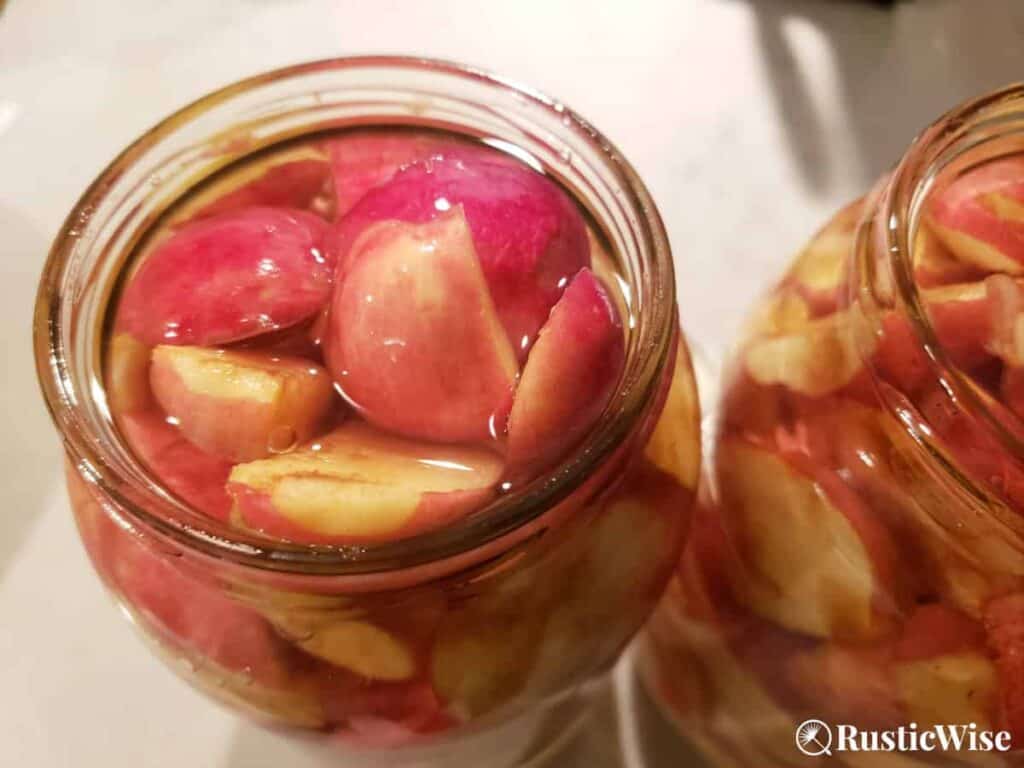
Basic DIY crab apple liqueur recipe
The first step of picking the fruits, washing, cutting, and removing seeds and stems is the most time-intensive. After that, it’s mostly hands-off.
Note: The proportions of sugar provided below are for jars that are roughly 1-quart size. Wide-mouth jars make packing and filling easier. Feel free to also use a gallon jar if you have one, but you’ll need to adjust the amount of sugar or sweetener.
Ingredients:
- Crab apples, coarsely chopped
- 1 cup vodka or whisky
- ¾ cup sugar
- Cloves
- Cinnamon sticks
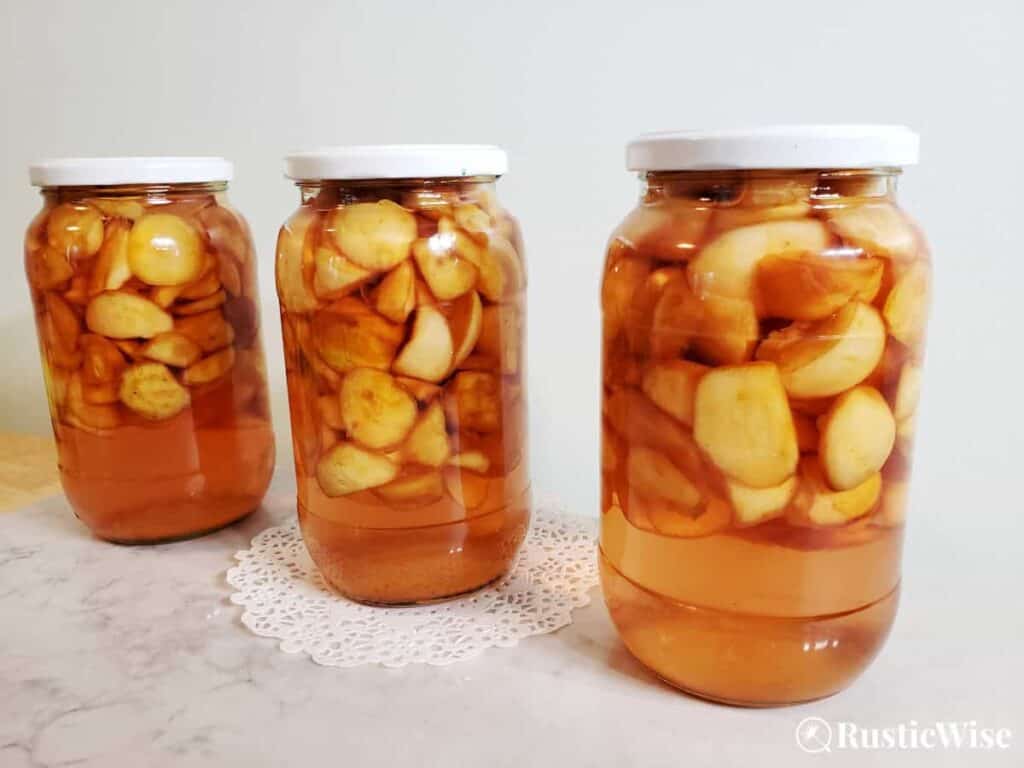
- Gather and wash apples in clean, cool water.
- Remove the cores, seeds, and stems. Chop into coarse chunks. Remove any bruised bits. Quarter them, then cut in half again. While some people choose to leave the seeds or stems in, I think it’s better without them. One reason is they may develop a slightly bitter flavor over time. Secondly, it just makes the straining process easier.
- Pack fruit. Fill a jar with fruit pieces loosely until it’s roughly ¾ full.
- Mix alcohol with sugar. In a mixing bowl, combine 1 cup of vodka or whisky and ¾ cups of sugar to sweeten. Stir until sugar dissolves. Pour the mixture into a clean jar so that the apples are completely covered. Leave a bit of headspace. (It’s important that all fruit chunks are submerged in the liquid, or they’ll develop mold.)
- Add seasoning. Add a cinnamon stick and several whole cloves.
- Cover and let it sit. Screw the lid on and store in a cool, dark place for at least a month before straining. The longer you leave it, the more flavorful your liqueur.
- Shake it up. Remember to swirl the jar periodically to coax the infusion.
- Strain. This is an important step as it removes any debris or sediment and really improves the quality of the drink. There’s more than one way to strain the liquid. We used a simple funnel lined with a paper coffee filter. This method is slower. You could also use a fine sieve, a piece of cheesecloth, or a jelly bag from canning. Strain and pour into clean, sterilized containers.
Remember to label your bottle with the contents and date.
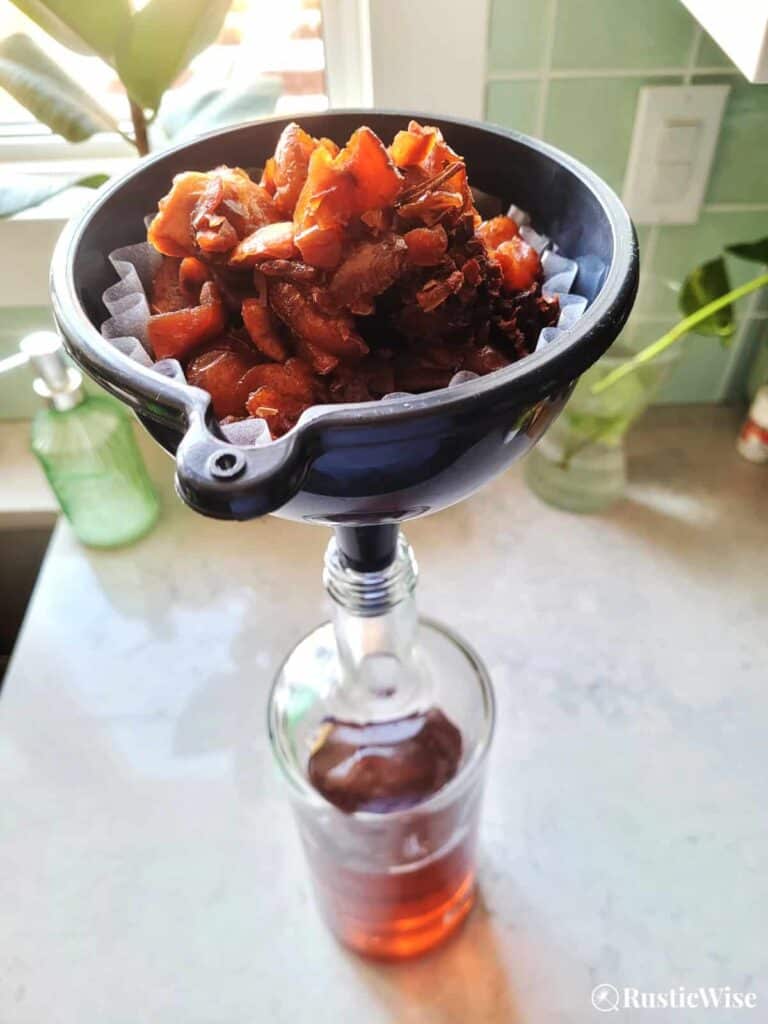
Enjoy! Now, close your eyes and let the aroma of the beverage transport you to an orchard on a warm, sunny day.
Our last batch was steeping for roughly a year and it’s probably our best one yet. This is a method where it gets better with time: the flavors get more complex and bold. But, if you’re in a hurry, you can enjoy your brew in as little as 14 days to a month.
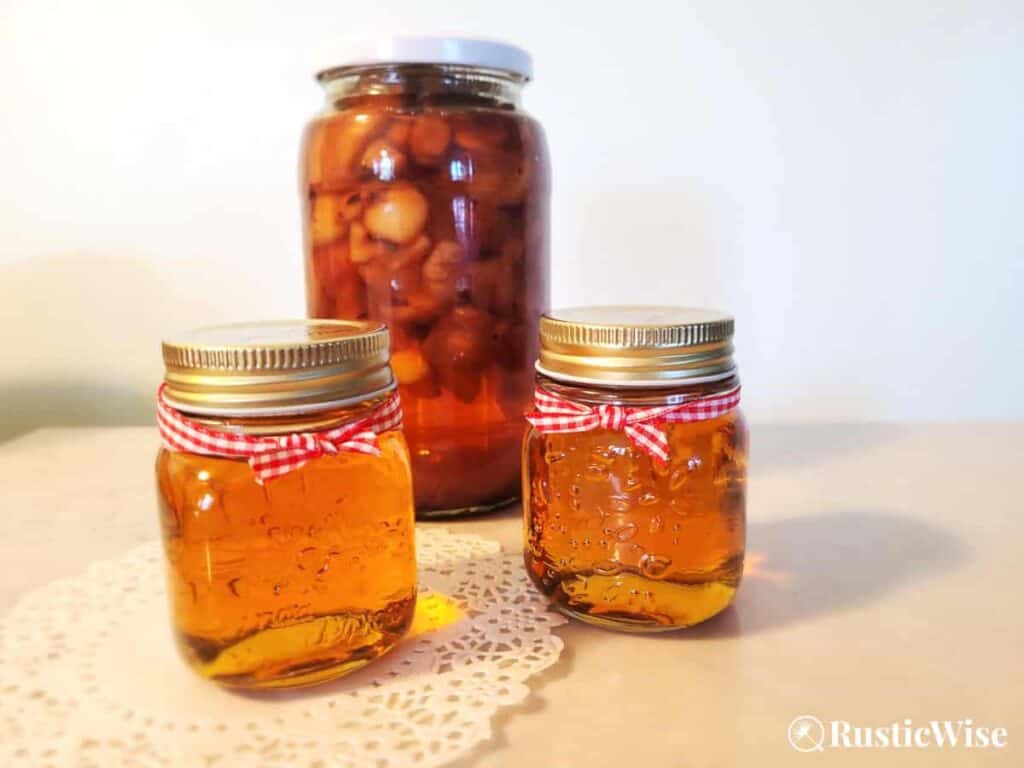
Bonus tip: Keep the liqueur-soaked apple slices
Being sweet tooths and gluttons, we felt it necessary to not throw out the alcohol-infused leftover apple chunks. So, we ate them! (This is another good reason to remove all seeds, etc. in the first step.)
If you want to make yourself a tasty treat, add a heaping of the apple remains on top of vanilla ice cream (caramel, maple, or butterscotch would also be wonderful). Enjoy!
(Obviously, please don’t serve this to kids as you can really taste the alcohol.)
Other types of liqueur to make
Once you’ve mastered this basic recipe, experiment with other fruits you have on hand.
Blackberry, cherry, cranberry, and peach, come to mind. Limoncello (made with tons of lemons) is also something on my to-make list.
Besides fruit, I’ve heard of people making delicious walnut brews. I haven’t yet had the delight of tasting this yet, but I’m certainly up for it if anyone wants to send some my way. 🙂
👉 If you like this post, see our Rustic Kitchen section. 🍽️
Would you like more timeless tips via email?
Fun tips to help you live an independent, self-sustaining lifestyle. Opt-out at any time.



Author: Josh Tesolin
Josh is co-founder of RusticWise. When he’s not tinkering in the garden, or fixing something around the house, you can find him working on a vast array of random side projects.

